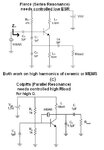malaganas
Newbie level 4
Hi,
I have been reading that different XO architectures are limited by the oscillation frequency of the crystal i.e. the famous pierce/collpits oscillators are limited until 200MHz crystal frequency.
In what sense is that correct? Is the limitation factor the amount of negative resistance provided by the core circuit or is it something else that I am missing?
In this case for high frequency crystals (>200MHz) what architectures are more suitable and why?
Regards
I have been reading that different XO architectures are limited by the oscillation frequency of the crystal i.e. the famous pierce/collpits oscillators are limited until 200MHz crystal frequency.
In what sense is that correct? Is the limitation factor the amount of negative resistance provided by the core circuit or is it something else that I am missing?
In this case for high frequency crystals (>200MHz) what architectures are more suitable and why?
Regards
